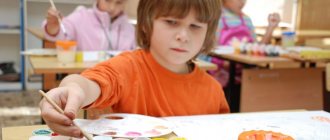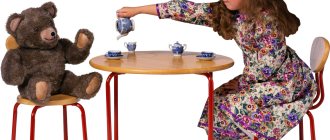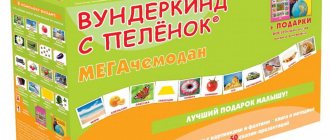Fairy tale as a literary genre
It is impossible to determine exactly when people began to compose fairy tales. Probably, this custom originated with our ancestors even when speech appeared, although not in the modern sense. To delve deeper into the history of the fairy tale, let’s figure out what it is and what its features are.
What is a fairy tale?
Authoritative Russian teacher Svetlana Belokurova writes that a fairy tale is an epic genre of folk art, a prosaic oral story about fictional events. The peculiarity of a fairy tale is that its plot is based on fiction, in contrast to such genres of folklore as epics, myths, legends, etc.
A fairy tale is most often understood as a folklore (folk) work that was created and transmitted orally. Later, the genre of literary fairy tale appeared. Such a work has one author, it is enshrined in writing, and its plot is often associated with a folk tale.
“The Sleeping Princess”: Wikipedia/V. M. Vasnetsov
What are the characteristics of the fairy tale genre? It can be recognized by the following characteristic features:
- The plot is based on the confrontation between good and evil. Positive characters (sleeping beauty, Ivan the Fool, Ivan Tsarevich, batyr, Aldar-Kose) personify people’s ideas about high morality, justice, true beauty, etc. Negative characters (the evil stepmother, Kashchei the Immortal, Zheztyrnak , Albasty, etc.) usually symbolize dark forces alien to man.
- Stable phrases are used. For example, at the beginning of the story we often find “Once upon a time...”, “In a certain kingdom, in a certain state...”, at the end - “They began to live and live well and make good things”, “A fairy tale is a lie, but there is a hint in it, kind Well done, a lesson."
- Events are filled with magic. Often the main character or his assistants are endowed with special abilities or use wonderful objects or resort to the help of magical animals.
- The character in a fairy tale is static, his character does not change throughout the story. Good heroes always defeat bad ones, and evil always gets what it deserves.
As philologist Elizaveta Namychkina notes, a fairy tale is intended to entertain and surprise, but also to instruct. Every story has a moral; through such stories people expressed their views on good and evil, moral standards, and values.
“Kashchei the Immortal”: Wikipedia/V. M. Vasnetsov
How did the fairy tale genre appear?
The fairy tale began to be identified as a separate genre no earlier than the 17th century. Before this, the boundaries between epic genres were blurred; a fairy tale can be understood as any oral story based on fictitious or semi-fictional events.
In ancient times, such stories were the main tool for transmitting information. Through myths, legends, and epics, people conveyed their understanding of the world and explained phenomena that they could not study and understand.
Over time, humanity has developed more ways to explore the world around us. The fairy tale has lost its original function and has become an exclusively artistic unit. Fictional stories were used for entertainment and edification, and were told mainly to children.
Fairy tales were passed down from generation to generation, they acquired new details. Therefore, most fairy tales have several variations, but the main plot and message are always the same. This is how people coded their wisdom in fairy tales.
Fairy tale as a literary genre: Unsplash
Teach good
Thoughtful, caring and wise parents, teachers and psychologists constantly ask themselves the question: “How to raise and raise a happy, successful, physically and morally healthy child?”
The search for an answer to this question often leads us to analyze various theories of education and training in order to take into account all the pros and cons of a particular method. At the same time, we forget that wise humanity has been looking for answers to such questions for thousands of years, not only searching, but also finding. Finds and passes on from generation to generation through a fairy tale, legend, parable. The history of the development of man and humanity is encrypted in a fairy tale. So that each new generation, through a fairy tale, can absorb this knowledge about the world, about the philosophy of life. “Today we associate the term “fairytale therapy” with this phenomenon, understanding by it ways of transmitting knowledge about the spiritual path and social realization of a person. That is why we call fairy tale therapy an educational system consistent with the spiritual nature of man.”
It is known that until approximately 10-12 years of age, the “right-hemisphere” type of thinking predominates in children. Therefore, the most important information for their development and socialization should be conveyed through vivid images. That is why fairy tales and mythological stories are the best way to convey knowledge about the World to a child.
The fact is that the most important universal knowledge is encrypted in the imagery and plot of fairy tales (old and new, folk and original). Moreover, this knowledge covers all spheres of human life:
- area of relationships between people;
- tools for overcoming difficulties and resolving conflicts;
- scenarios of “fighting evil” external and internal;
- recommendations for coping with stress;
- typologies of people and ways of influencing them;
- spiritual development of a person;
- male and female psychology.
That is why telling fairy tales is necessary for a child’s life, for his development, the formation of the most important skills, for his adaptation in the social world, for his subsequent spiritual self-realization.
If the first decade of life in this regard develops favorably (caring parents and teachers read, told fairy tales, discussed them together), then a kind of “bank” of life situations is formed in the unconscious of the little person, that is, a set of knowledge about the dynamics of internal processes, ways of relationships between people, opportunities for self-realization, the structure of the World, etc.
Read and discuss fairy tales!
If fairy tales and mythological stories were not discussed with the child, but were simply read or told to him, this “bank”, this knowledge is in a passive state. This is also wonderful, because in any case the child has the resource for successful socialization.
If adults have found the strength and wisdom to discuss fairy tales with a child, comprehend life lessons, and look for parallels with real phenomena, then the “bank” of knowledge about the World goes into an active state. What does it mean? The child naturally develops the ability to act consciously, to see cause-and-effect relationships between events; exploring his own abilities and capabilities, he reflects on his purpose; consciously and unconsciously manifests the creative hypostases of the soul.
Is this important for the child? Isn’t it too early for him to think about such “serious” things? “It’s important and not too early!” - say fairytale therapists. “Moreover, later it may be too late. If we look around, we will see what the destructive actions of an adult, obsessed with the illusion of his own impunity and denying the “fairytale” laws of interaction with the World, have led to.
Maybe fairy tales are “trifles” and “frivolous”, but they do not destroy the world around them, but appeal to the bright creative sides of the human soul. Therefore, fairy tale therapy with children, adolescents and adults is especially relevant today. If only because it is necessary to stop the avalanche of destruction caused by man. And this can only be done if a person returns to his original, “fairy-tale” perception of the world
»
So, it is not enough for a modern child to simply read a fairy tale and talk about the characters and plot. With a child of the third millennium, it is necessary to comprehend fairy tales, together to search and find hidden meanings and life lessons. And in this case, fairy tales will never lead the child away from reality (as some mistakenly believe). On the contrary, they will help him become an active creator in real life. The main thing is to plant a seed of comprehension in the child’s soul.
“Unraveling”, “deciphering” fairy tale lessons and meanings is a living creative process, a joint joy of thinking and learning between a child and an adult. To solve fairy tale lessons, we, adults, do not need to know everything in advance; we can make assumptions, relate fairy-tale situations to reality, fantasize and joke. After all, in fact, it is co-thinking, co-cognition, co-creation with an adult that is the main driving force of a child’s development. Some of your child’s questions cannot be answered right away. It is important for an adult not to be afraid to say: I don’t know yet, but let’s think about it together.
After all, wise people say:
“It’s impossible to ask a question if somewhere in the depths of your mind you don’t know the answer.”
True, it happens that answers come after some time. And sometimes it is even useful to leave the child with some question inside.
How to find life lessons in fairy tales?
But what is it like to comprehend fairy tales? How to find hidden life lessons in them? Fairytale therapists compare a fairy tale to a layer cake - a “layer cake of meanings.” A fairy tale carries specific information, but only at each specific stage of its development does a child, teenager or adult assimilate and analyze its different layers.
Traditionally, in Russian culture, a child begins his acquaintance with fairy tales with folk tales, simple and melodious, fairy tales with a frequently repeated refrain, fairy tales that are by no means simple, because they contain deep knowledge about things that are very important to a person. These tales tell us that the world around us is alive. At any moment, everything can speak to us, provide help, or block our path. The revived objects of the surrounding world can act independently, have their own feelings, thoughts, desires. In the world there is always a place for help and deceit, acceptance and envy, truth and lies. In this world there is evil and there is always good, which ultimately wins.
The fairy tales “Kolobok”, “Teremok”, “Ryaba Hen”, “The Wolf and the Seven Little Goats” can be considered as warning tales about the pitfalls of social reality. Then, using the example of heroes who find themselves in a difficult situation because of their stupidity, carelessness, and illiteracy, the fairy tale shows the child the consequences of immature, frivolous actions.
"Be careful. It’s not in vain that people learn, observe each other and the world. One wrong action, one careless word, and your rival or enemy will take advantage of it.”
– the fairy tale whispers to the child’s subconscious.
However, you should not think that fairy tales instill fear in a child and increase his level of anxiety. Fairytale therapists believe that, firstly, a certain level of anxiety is necessary; secondly, fairy tales thus form a normal social tone
child, mandatory for self-realization; thirdly, they provide the child with clear models of effective and ineffective behavior. Thus, discussing fairy tales and searching for life lessons becomes prevention, psychological hardening against many problems that a child will encounter when he gets older.
Here are some more examples of meaningful work with fairy tales... Children under five years old identify themselves with animals and try to be like them. Therefore, it is fairy tales about animals that best convey life experience to young children.
Fairy tale by V. Suteev “One, two - together!” will help discuss the idea with the kids: we are very strong when we are all together; In our unity, everyone is very important, even the small and weak.
Topics for reflection and discussion with preschoolers based on another fairy tale by V. Suteev, “The Magic Wand”: “The Magic Wand” is your intelligence, quick wit, and resourcefulness; what can you call a person who sees the unusual in ordinary things; Why is it more interesting for “creators” to live in the world?
V. Kataev’s fairy tale “The Seven-Flower Flower” provides an opportunity for older children to think about what it means to help another; why can’t we do without this in the human world; what does the proverb mean: “To do good is to amuse yourself”?; what are the values (material and spiritual). Tove Jansson's fairy tale “The Invisible Child” will tell children and adults about the value and uniqueness of each individual.
A long time ago, our wise ancestors shared the methods of raising girls and boys. Masculinity was developed in boys, femininity in girls. Every person has masculine and feminine, and there is strength in their interaction. However, we can conditionally divide the fairy-tale-mythological heritage into “male” and “female”. At the same time, it is important to remember that through reading “male” fairy tales, a girl learns about the male world and her masculinity. A similar logic applies to the boy.
In “male” fairy tales, the main character is a male character. “Male” fairy tales include all myths and legends about heroes, as well as fairy tales whose main characters are male. In "women's" fairy tales, the main character (or heroines) is a female character. There are "mixed" fairy tales in which there are two main characters of both sexes. “Male” fairy tales reflect male strategies of behavior, attitudes towards life, lessons, while “female” ones reflect female ones. “Mixed” tales tell about the relationships and mutual influence of masculinity and femininity and their harmonization.
The most popular fairy tales for boys are “The Three Little Pigs” and “Kolobok”. They manifest the most important archetype of Struggle for a man. Moreover, if “The Three Little Pigs” shows a successful scenario of a winner of a superior enemy, then “Kolobok” (where the Road archetype is additionally updated) contains an important warning about the conditions under which one can be defeated. In fact, using these simple stories, one can explain to a boy various ways of overcoming obstacles, the typology of the enemy, the preferred scenarios for fighting and winning against him. All this should be included in the “men's library” of models for achieving success.
The most popular “women's” fairy tales are “Little Red Riding Hood”, “Masha and the Bear”, “Little Khavroshechka”, “Cinderella” and others. If “male” fairy tales do not always have female characters, then all “female” fairy tales always have a male character (zoomorphic or anthropomorphic). The heroine either has to build a relationship with him, entering into a fight (“Little Red Riding Hood”, “Masha and the Bear”), or she prepares herself for a happy marriage (“Kroshechka-Khavroshechka”, “Cinderella”, “Morozko”). The dreams and actions of female heroines are necessarily directed towards a man (except for the Amazons). No wonder. The principle of Love and procreation, fundamental for a woman, cannot be realized without the participation of a man. In fact, “women's” fairy tales help a girl understand the meaning of femininity and the mystery, variations of relationships with a man. The very nature of femininity is very subtle, fragile, changeable, diverse, so it can only be described and talked about in the language of metaphor.
By telling a child fairy tales, discussing them, that is, by engaging in fairy tale therapy, an adult takes care of the development of his soul and intellect.
In addition, “fairytale therapy is also the “nutrition” of the life axis, the moral core of a person. Fairy tale therapy requires patience and wisdom from both the psychologist and the parent. A fairy tale becomes a context, a starting point for joint reflection between a child and an adult” (T. D. Zinkevich-Evstigneeva, 2005).
Fairytale therapy has no age limits; each age has its own “layer of meaning,” its own fairy tale, and its own ways of interacting with it. Children, traveling through a fairy tale, “get wiser,” learn about life, and acquire social skills. For teenagers and adults, the emotional aspect (“remembering” a fairy-tale, that is, harmonious worldview) is the door to their personal resource. By immersing themselves in a fairy tale, teenagers and adults can gain strength and open up new opportunities for creative, constructive changes in the real situation. And having discovered a resource within themselves, a teenager and an adult switch to the events of their lives, interpret them a little differently and begin constructive social modeling. For adolescents and adults, the cognitive (analysis of fairy tales) and creative (composing, dramatizing fairy tales, drawing, creating dolls, etc.) aspects of fairy tale therapy are especially important.
And one more important secret of the method: in fairy tale therapy, the action is important, but the CONSEQUENCE is more important. It is the aftereffect of fairy tale therapy that is a powerful force that stimulates personal development. Development independent of the teacher, psychologist, psychotherapist. Own DEVELOPMENT.
Fairytale therapy is addressed to the pure and receptive childish nature of every person (that is why it is called the “children’s” method). There is an ancient parable about
that a person in his development goes through 3 stages: Camel, Lion and Child. Being at the Camel stage, he obeys the rules, carries the burden of everyday worries, and does not resist circumstances. Like a camel crossing the desert, a person at this stage has a large reserve of vitality. When the resource of patience and strength of the Camel runs out, the person moves to the Leo stage. Now he actively resists circumstances, denounces offenders, fights for justice, and reaches certain heights of social status. But a moment comes when Leo realizes that everything he devotes his life to takes him away from the truth. Immerses you in a whirlpool of vanity and an abyss of insoluble problems. Leo is aware that his life, despite the brilliance of achievements and apparent meaning, is devoid of something simple and harmonious. And then the transition to the next stage of development occurs - the Child stage. Now a person looks at the world with an open, happy gaze, sees beauty in little things, he wants to learn what previously seemed obvious. He has a long journey of life behind him, however, there is no fatigue or pessimism in his soul. There is a desire to discover the world anew, comprehending the Truth...
Keeping this parable in mind, we can “define the subject of fairy tale therapy as the process of educating the Inner Child, developing the soul, increasing the level of awareness of events, acquiring knowledge about the laws of life and ways of social manifestation of creative creative power. The deep grain of fairy tale therapy lies in the life values that fairy tales convey.”
Pozdnyakova Larisa Lvovna
What types of fairy tales are there in literature?
Classifying folk tales is not an easy task. A lot of research has been devoted to it. All stories are different from each other, each has its own morality and way of resolving the conflict.
Most often in literature there is a division of the genre into three groups:
- fairy tales;
- tales about animals;
- everyday tales.
What are their distinctive features? Let's look at examples.
What is a fairy tale?
The fairy tale tells about unusual events in which fantastic characters take part - Morozko, Snow Maiden, Vodyanoy, Sun, Moon, Wind, Koschey the Immortal, Baba Yaga, etc.
As literary critic Elena Kovtun notes, the plot is based on the confrontation between good and evil, good heroes and bad ones. The main character of a fairy tale is a positive character. He is faced with a problem - a bereavement, the threat of some kind of disaster. The search for what is lost or missing becomes the main driver of the plot.
Along the way, magical helpers come to the aid of the hero:
- animals that can talk (horse, gray wolf);
- objects endowed with miraculous properties (mirror, rejuvenating apples);
- elements.
“The Frog Princess”: Wikipedia/V.
M. Vasnetsov This tale also has stylistic features:
- special poetic formulas (“neither to say in a fairy tale, nor to describe with a pen”, “far away lands”);
- trinity (three trials, three sons, three roads).
In Russian folklore, the fairy tales “The Frog Princess”, “Little Khavroshechka”, “Swan Geese”, “Ivan Tsarevich and the Gray Wolf” are considered magical. In the Kazakh fairy tale epic - “Savraska”, “The Spellbound Girl”, “Three Brothers and the Beautiful Ayla”, “Karazhay”, etc.
What is a fairy tale about animals?
In these tales, the main characters are animals, birds, fish, and sometimes plants, objects and natural phenomena. The person in the plot plays a minor or completely insignificant role.
In fairy tales, animals have human characters. Each animal often embodies one or more human qualities: greed, cunning, cruelty, cowardice, etc. The fact that people identified themselves with certain animals was reflected in some of the names of fairy-tale characters: Mikhail Potapovich, Lisa Patrikeevna, etc.
In the Russian epic, tales about animals are represented by the following examples:
- "The Fox and the Wolf";
- "The Wolf and the Little Goats";
- "Beasts in the Pit."
There are also Kazakh fairy tales:
- "The Fox and the Monkey";
- "The Dream of a Hungry Wolf";
- "Swallow and Mantis."
Animal Tale: Unsplash
Developmental aspect
A fairytale work develops the most important communication and intellectual skills in children:
- imaginative thinking; active speech; attention; the ability to coherently express a thought; creativity and imagination; all types of memory; the ability to correctly use facial expressions.
The characters' remarks train the articulatory apparatus and enrich the vocabulary.
The culture of speech develops, the skill of correct pronunciation of rarely used words is formed. If the fairy tale is a Russian folk tale, then the child’s speech organically includes proverbs and sayings. Thus, thanks to folklore, the child is drawn into the space of folk culture.
Numerous options for using literary material give the baby the opportunity to fully realize their potential. Expressive reading, theatrical performance, puppet or finger theater, drawing - you can play out the plot in different ways. The child feels joy, creative freedom, elation, becoming an inhabitant of a fairy-tale world.
Photo: fairy tale “The Ryaba Hen”
It is important to know:
- The role of play in raising a preschool child




